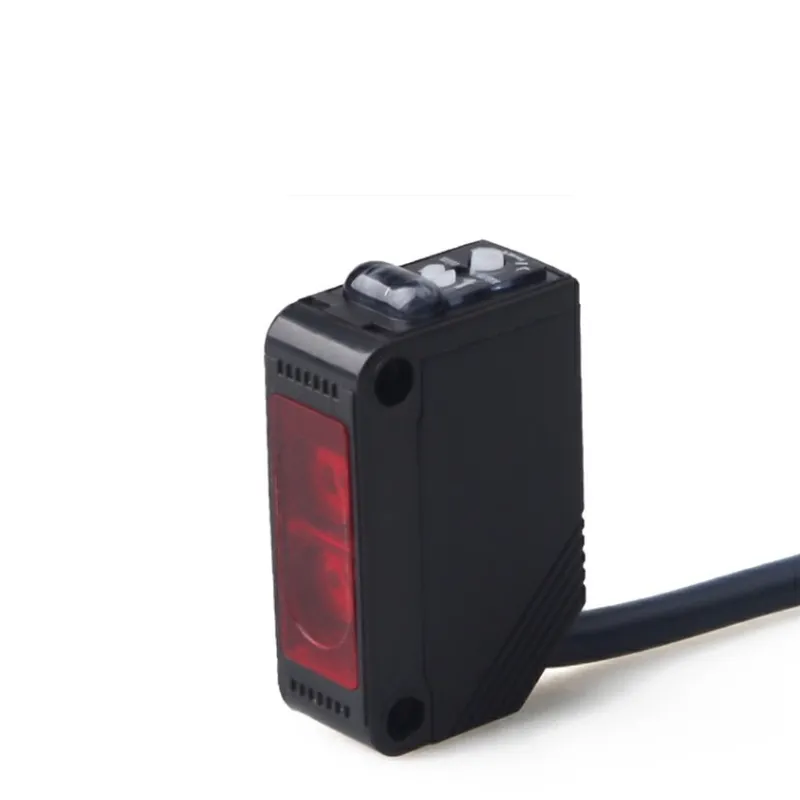Core Mechanisms of Photoelectric Switches
Through-Beam and Retroreflective Sensors
There are two main types of photoelectric switches based on through-beam sensors or retroreflective sensors. Through-beam sensors operate by sending a beam of light from an emitter to a receiver. When something moves into the path of that light, the sensor notices. This method seems ideal when a high-precision measurement over a long distance is required, with reliable results. Retroreflective sensors, however, bounce light off a reflective surface and back to the sensor. There is no need for a direct line of sight for these sensors, which are suitable for confined spaces, or places with different light levels.
Diffuse Sensing Technology
The diffuse sensing technology wants no reflectors which simplifies the detection. The performance of this technology is accomplished at relatively short distances and outdoor environments, and is cost-effective. Unlike through-beam and retroreflective sensors, diffuse sensors sense the target within the light cone that is emitted, confirming the object's different properties such as color and material. Such capability is very useful in industrial environments for purpose such as sorting and inspection where it is crucial to separate between different object properties.
In conclusion, photoelectric switches, enhanced by these technologies, offer reliable, precise, and versatile sensing solutions ideal for modern automation needs.
Operational Advantages for Industrial Efficiency
Error Reduction in Quality Control
Photoelectric switches transform the way companies control quality as they drastically reduce human error, reducing error by as much as 80% once automated. Such an extraordinary reduction is only realizable because the photoelectric switches are in the position to continuously control the materials requirement. They automate the detection step here, to guarantee that a product will reach shipping with very exact quality levels. This automated process improves repeatability of results as well as consumer confidence in product transparency. This enables them to maintain high standards and better delivery quality by rapidly detecting defects or deviations.
High-Speed Object Detection
High speed photoelectric switches can be applied to all kinds of industries to improve the efficiency. These units claim detection times that are under milliseconds, making them a requirement for any assembly line impact detection. The rapid response of these switches is ideal for use in production lines, which are under more and more pressure: Operations will not be impeded as potential bottlenecks are eliminated. This feature increased the throughput and reduced the cost of operation by enabling systems to operate continuously. Good production improve opportunities to be productive, minimize costs and the use of resources.
Material and Environmental Versatility
Detecting Non-Metallic Substances
It is a notable point that photoelectric switches are very useful sensors for material detection, not only of metallic but also non-metallic materials such as dielectrics and plastics, since their sensitivity can be designed useful in a highly optimized way. This is particularly important in applications such as packing and warehousing, where flexibility in material detection can drive process innovation. The application of photoelectric switches for non-metal detection is more than a conventional metal detection system. Their use in many areas of production announces a new age of technology. The ability to sense materials like glass, plastic, and other transparent materials enables a wide array of applications, and enables manufacturers to make their lines more versatile and efficient. This adaptability not only improves current working processes, but also utilizes inspiration to address newly identified manufacturing problems.
Performance in Contaminated Environments
Photoelectric switches continue to function perfectly and reliably even in soiled environments such as in the food and beverage industry where cleanliness is an absolute requirement. Its durable design withstands the harshest conditions, ensuring its functionality remains intact anywhere cleanliness is an absolute necessity. Facilities that integrate photoelectric switches into potentially-contaminated processes reduce, by as much as 30 percent, the risk of product contamination for better brand integrity and consumer safety. And resistant to environmental conditions, the device continues to operate smoothly even under less than ideal ambient conditions, to satisfy customers' high standards for food and pharmaceutical production.
Cost-Effective Solutions for Energy Efficiency
Long-Term Affordability
Photoelectric switches are a one-time expense, albeit a substantial purchase, yet so cost-effective they fit into a budget with surprising ease. These switches deliver dramatic energy savings, significantly reducing operational costs and eliminating ongoing maintenance expenses this remarkable level of durability makes them more than serviceable through their previous service life. Additionally, studies show that industries could make more than 20% yearly savings in energy costs by properly managing photoelectric technologies. This advantage enables the reduction of costs and the maintenance of high levels of production through applications systems to automate the latter. A time-proven photoelectric switch application promises to be a recipe for business success, adding to the bottom line - without sacrificing productivity.
Energy-Efficient LED Operation
Sensors with LED technology are particularly energy efficient and can last up to 50,000 hours. LED LightsThese products require less energy to power the device, same performance effects.No longer to worry about losing power when comparing with those general MP players.SupportL Battery Life This series players have long battery life, you can also save the power by turning off the screen through button lock. Research shows that LED-based sensor technology can reduce consumption of energy by as much as 90% when compared to the equivalent incandescent, leading to long term energy conservation. This is a forward-looking solution, which meets not only international energy standards, but also encourages environmental leadership in various industries. The use of LED technology assists that companies with their operational efficiencies and environmental friendly operations which is in high demand today for an environmental sustainable manufacturing process.

Safety Enhancements in Industrial Automation
Integrated Safety Light Curtains
Safety light curtains with photoelectric switches have an important application in safety protecting the working staff in an industrial site. With a complete detection of people in danger areas these systems can avoid accidents by moving machinery. The features are the following, detection through photoelectric switch, providing with precise and reliable monitoring, can work out break-ins or intrusions in the protected area. This allows equipment to stop immediately to avoid possible injury to workers. By the numbers, safety light curtains can lower accidents on industrial sites by as much as 40%, an impressive savings on safety standards for the worker.
Accident Prevention Systems
With the support of photoelectric switches, accident prevention systems are essential components of current industrial safety arrangements. These facilities are set up to respond to emergencies quickly and to minimize workplace injuries. Whenever a threat is identified, those photoelectric switches can stop the machinery nearly immediately, cutting down on the potential of accidents. Experts point out that automated voice-activated systems are compliant with safety rules, and these responses are promoting more regulations, in turn, creating a safer workplace. The rapid and accurate response of the photoelectric switches is advantageous for improving safety and more attractive reason for use in industry.
Industry-Specific Applications Driving Efficiency
Food Processing Hygiene Standards
In the food processing sector, cleanliness is critical to the health protection and quality of consumer goods. Photoelectric switches play a crucial role in adhering to these ambitious hygiene requirements. They are noncontact devices, making them less likely to be contaminated in production processes as they detect without touching. This capability fits in well with the emphasis regulatory agencies place on not allowing food processing environments to become contaminated. With the use of photocell switches, factories can improve hygiene standards, so the product is safe for consumers and arrives in line with the strict health & safety regulations laid down by health bodies.
Automotive Production Line Optimization
Automotive industry production lines are by nature, not the least in car manufacturing do efficiency and precision really count, and in this field photoelectric switches have made a significant contribution to the establishment of process-optimized production. They reduce assembly time since they allow for high-speed operations and less downtime. According to research, car manufacturers can achieve a 25% increase in production efficiency by using photoelectric switching technology and this dramatic increase leads to increased output and lower production costs. This would make it not only faster to produce but also higher quality in the vehicle built as things are lined up and bolted on correctly.
FAQ
What are the core mechanisms of photoelectric switches?
Fundamentally, photoelectric switching dives in for cues, retro-reflective sensing and diffuse sensing. Through-beam sensors operate by sending light from an emitter to a receiver; the light beam is interrupted, thus triggering the sensor. Sensors that rely on reflected surfaces rather than a clear beam. Transmissive sensors detect objects in the emitted light cone.
How do photoelectric switches reduce errors in quality control?
Photoelectric switches minimize human errors and automate the detection process in quality control. They ensure products meet precise standards before reaching the shipping phase, enhancing statistical reliability and consumer trust.
In which industries are photoelectric switches commonly used?
Photoelectric switches are commonly used in industries such as food processing, automotive manufacturing, packaging, and warehousing for tasks like hygiene maintenance, production line optimization, high-speed object detection, and non-metallic substance detection.
Why are LED-based photoelectric switches considered energy efficient?
LED-based photoelectric switches consume less power compared to traditional alternatives. Their energy-efficient operation aligns with global energy standards and sustainability initiatives, making them a preferred choice for eco-friendly practices.

